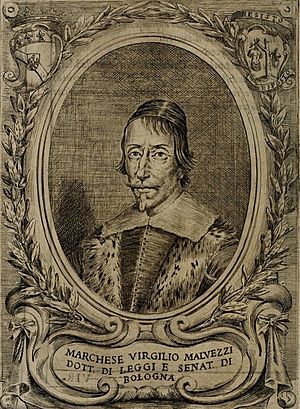Virgilio Malvezzi facts for kids
Quick facts for kids
The Most Illustrious
Virgilio Malvezzi
|
|
|---|---|

Virgilio Malvezzi
|
|
| Born | 8 September 1595 |
| Died | 11 August 1654 (aged 58) Castel Guelfo, Bologna, Papal States
|
| Resting place | San Giacomo Maggiore, Bologna |
| Other names | Grivilio Vezzalmi |
| Alma mater | University of Bologna |
| Occupation |
|
| Parent(s) | Piriteo Malvezzi and Beatrice Malvezzi (née Orsini) |
| Relatives | Francesco Sforza Pallavicino (nephew) |
| Writing career | |
| Language | Italian, Spanish |
| Notable works | Discorsi sopra Cornelio Tacito Il Tarquinio Il Ritratto del Privato politico christiano |
Virgilio Malvezzi, also known as the Marquis of Castel Guelfo, was an important Italian writer, soldier, and diplomat. He was born in Bologna on September 8, 1595. He became the official historian for King Philip IV of Spain. Many famous writers, like Francisco de Quevedo and Baltasar Gracián, admired his work.
Contents
His Life Story
Virgilio Malvezzi came from a rich and important family in Bologna. His family's main home was the estate of Castel Guelfo di Bologna. His father was a senator, and his mother was from the famous Orsini family in Rome.
After studying law at the University of Bologna, he moved to Siena with his family in 1616. There, his father was made governor. In Siena, Virgilio became good friends with Fabio Chigi, who later became Pope Alexander VII.
Soldier and Diplomat
Following his family's tradition, Virgilio joined the Spanish army in 1625. He fought in Flanders and Piedmont. He got sick and returned to Bologna in October 1625. In 1627, he inherited his father's title and lands.
In 1635, Malvezzi wrote a book called Il ritratto del privato politico christiano. It was about Gaspar de Guzmán, Count-Duke of Olivares, who was the chief minister to King Philip IV of Spain. This book caught Olivares's attention. He invited Malvezzi to Madrid in 1636 to become the official historian for King Philip IV. Malvezzi also became a member of the King's important councils.
In the early 1640s, King Philip IV sent Malvezzi on several important missions. In 1640, he was sent to England to try and stop the marriage of Mary Stuart. In 1641, he went to Flanders to advise the Cardinal-Infante Ferdinand of Austria.
Later Years
In 1645, Malvezzi joined a famous group of scholars and artists in Bologna called the Accademia dei Gelati. He was the leader of this group for two years. He was also a big fan of painting and was friends with famous artists like Guido Reni and Diego Velázquez. He supported many artists.
Virgilio Malvezzi passed away in Bologna on August 11, 1654. He was buried in the Church of San Giacomo Maggiore.
His Writing Style
When he was young, Malvezzi wrote about the Roman historian Tacitus. He became known for his Christian Neostoicism, which was a way of thinking that combined ancient Greek philosophy with Christian ideas. He was also a humanist, focusing on human values and achievements.
Malvezzi used a special writing style. It was short and to the point, like the writings of Tacitus and Seneca. Many people, especially in Spain, loved his style. They called it "elegantly laconic," meaning it was short but very clever.
However, some people found his writing hard to understand. The writer John Milton even joked that Malvezzi "can cut Tacitus into slivers and steaks."
Malvezzi believed that a little bit of mystery in writing could be good. He thought it made the reader think more and use their own imagination. The Spanish writer Baltasar Gracián greatly admired Malvezzi's unique way of combining history with philosophical ideas.
Political Ideas
Malvezzi's political ideas were similar to those of Machiavelli, another famous Italian thinker. He wrote several political biographies about important leaders from Roman and Jewish history. These included Romulo (1629), Tarquinio il Superbo (1632), and Davide perseguitato (1634). In his book Tarquin, he even discussed how leaders sometimes need to hide their true intentions in politics.
His book about Olivares, Ritratto del Privato Politico Christiano, praised Olivares. It argued that Olivares was right to use "reason of state" to protect the Spanish Empire. "Reason of state" means doing what is best for the country, even if it's not always popular.
English Translations of His Works
Many of Malvezzi's books were translated into English. For example, his Discourses upon Cornelius Tacitus was translated by Sir Richard Baker in 1642.
Henry Carey, 2nd Earl of Monmouth translated both Romulo and Il Tarquinio Superbo. These were published together in 1637.
Other works, like David Persecuted and The Chiefe Events of the Monarchie of Spaine, were also translated into English. This shows how popular and influential his writings were across Europe.
His Works
Virgilio Malvezzi wrote in both Italian and Spanish. His books were quickly translated into many other languages, including Latin, German, English, and Dutch.
Some Translated Works
- El Romulo (Spanish translation by Francisco de Quevedo)
- Tarquino el Sobervio (Spanish translation)
- David perseguido (Spanish translation)
- Virgilio Malvezzi, Retrato del privado christiano politico (Spanish translation)
- Davide Perseguitato: David Persecuted (English translation by Robert Ashley)
- Romulus and Tarquin (English translation by Henry Monmouth)
- Der Verfolgte David (German translation)
- Tarquin le superbe (French translation)
- The Pourtract of the Politicke Christian-Favourite (English translation)
- The Chiefe Events of the Monarchie of Spaine, in the Yeare 1639 (English translation by Robert Gentilis)
- Considerations upon the Lives of Alcibiades and Coriolanus (English translation by Robert Gentilis)
- Historisch-polityke werken des markgraefs Virgil Malvezzi (Dutch translation by Mattheus Smallegange)
See also
 In Spanish: Virgilio Malvezzi para niños
In Spanish: Virgilio Malvezzi para niños

